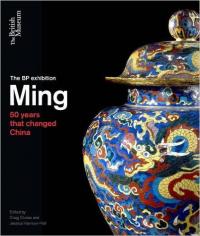Professor Craig Clunas
Craig Clunas has recently completed a book on the cultural role of the Ming regional aristocracy, Screen of Kings: Art and Royal Power in Ming China,(Reaktion Books, 2013). In 2012 he delivered the AW Mellon Lectures in the Fine Arts at the National Gallery of Art, Washington DC, on 'Chinese Painting and Its Audiences', and is currently working on a book of the same title.
Craig Clunas is co-curator of a major British Museum exhibition on the early Ming period scheduled for 2014, the reserach for which is funded by the AHRC.
Ming: 50 years that changed China

Ask anyone what single object they associate with China and the most common answer will be a Ming vase. Probably without even knowing the dates of the Ming dynasty (1368–1644), people are aware of the fragility of its porcelain, its rarity and value. But porcelain is just one part of the story of one of the most glorious époques of China’s past. By focusing on the significant years of the early Ming dynasty and through the themes of court people and their lives, extraordinary developments in culture, the military, religion, diplomacy and trade, this magnificent book brings the wider history of this fascinating period to colourful life. This was an age of great voyages of exploration, undertaken for many reasons including trade and diplomacy. Long before the regular arrivals of Europeans in China, court-sponsored expeditions were sent to Asia, the Middle East and the African coast, bringing back knowledge of and objects from lands thousands of miles away – gold, gems and foreign fashions. This period also saw the compilation of the world’s first comprehensive encyclopaedia (worked on by over 2000 scholars); the undertaking of major building projects such as the Forbidden City and Ming tombs; the creation of beautiful textiles, paintings, ceramics, gold, jewellery, furniture, jade and lacquer. The engaging narrative is richly illustrated with over 250 images, drawing on the objects specially selected for the British Museum’s major exhibition. Some of these are the finest pieces ever made in China.
Craig Clunas has recently completed a book on the cultural role of the Ming regional aristocracy, Screen of Kings: Art and Royal Power in Ming China,(Reaktion Books, 2013). In 2012 he delivered the AW Mellon Lectures in the Fine Arts at the National Gallery of Art, Washington DC, on 'Chinese Painting and Its Audiences', and is currently working on a book of the same title.
Professor Clunas is co-curator of a major British Museum exhibition on the early Ming period scheduled for 2014, the reserach for which is funded by the AHRC.
He is involved in the following research projects:
Ming: Courts and Contacts 1400-1450
This research project sought to provide a new perspective on the history of a period of crucial importance to China and the wider world, a history that for the first time fully integrated the evidence of material culture with the enormous textual record. The years 1400 to 1450 saw the creation or consolidation of many of the cultural, social and political themes which were to dominate China’s history from then on. These include developments as fundamental as the definitive decision to place the political capital in the north, while the south-central region became economically dominant (a dichotomy which still pertains today). The early Ming period defines contemporary Chinese conceptions of their own history, and China’s relations to the rest of the world. Understanding that history is crucial, if policy makers and a wider public are to comprehend China’s self-image, which is a key shaper of its current and future actions on the world stage. In contemporary China the period 1400-1450 is popularly regarded as a golden age of international engagement and a model for modern China.




